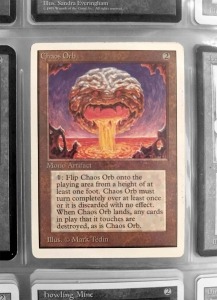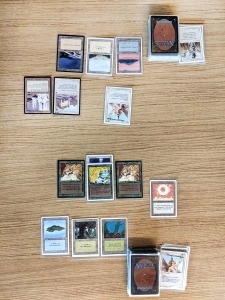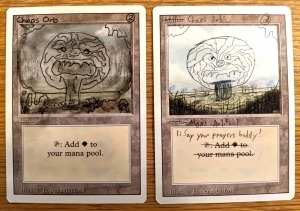 “Charming,” “whimsical,” “masterpiece,” “pretty funny” are just a few of the words used to describe the Magic: The Gathering card, the Chaos Orb. These accolades are for the card’s art, a bulbous, floating spherical monster endlessly drooling lava from its looming maw, as well as for the card’s powerful effect. But to understand the wild, disruptive effect of the card, it is good to know the basics of Magic.
“Charming,” “whimsical,” “masterpiece,” “pretty funny” are just a few of the words used to describe the Magic: The Gathering card, the Chaos Orb. These accolades are for the card’s art, a bulbous, floating spherical monster endlessly drooling lava from its looming maw, as well as for the card’s powerful effect. But to understand the wild, disruptive effect of the card, it is good to know the basics of Magic.
Magic: The Gathering was the first “collectible card game” and originally made its debut in 1993. To play the game, players buy packs of cards and use them to create a deck of cards that will battle against another player’s deck. There are a variety of card types, such as creature cards that stay on the battlefield to attack and defend, sorcery cards that provide one-time effects, and land cards that produce “mana”, or the currency used to play other cards. The Chaos Orb is an artifact card, a special type that occupies the battlefield but doesn’t have health or power like a creature. Instead it usually has a powerful effect that costs mana. The game is built around a system of rules, but most cards have effects that can bend or break these rules, creating an ever-evolving battlefield of strategy and unexpected surprises.
And for many players, the Chaos Orb must have been a most unexpected surprise. Card effects in Magic can cause major changes to gameplay, but they still operate within the system of the game, such as making a creature more powerful or allowing a player to draw more cards. However, the Chaos Orb’s effect is as follows:
Flip Chaos Orb onto the playing area from a height of at least one foot. Chaos Orb must turn completely over at least once or it is discarded with no effect. When Chaos Orb lands, any cards in play that it touches are destroyed, as is Chaos Orb.
 This acrobatic effect was unique, but not wholly out of place in the early Wild West days of Magic. The card game emerged as an instant hit from the time of its first release. Before the end of 1993, it had sold two print runs (the Alpha and Beta sets) totaling almost 10 million cards and had another 35 million card run (the Unlimited set) on the market. Tournaments sprang up almost immediately, and players soon discovered game-breaking combos with powerful cards (such as the famous Black Lotus card) and, when the Revised set was released in 1994, these powerful cards along with the Chaos Orb were not included.
This acrobatic effect was unique, but not wholly out of place in the early Wild West days of Magic. The card game emerged as an instant hit from the time of its first release. Before the end of 1993, it had sold two print runs (the Alpha and Beta sets) totaling almost 10 million cards and had another 35 million card run (the Unlimited set) on the market. Tournaments sprang up almost immediately, and players soon discovered game-breaking combos with powerful cards (such as the famous Black Lotus card) and, when the Revised set was released in 1994, these powerful cards along with the Chaos Orb were not included.
Even so, tales of the Chaos Orb live on, including a myth of a player who, about to lose, shredded his Chaos Orb into pieces so it rained down on the opponent’s cards, destroying that player’s entire set-up (and there’s a subsequent myth that the card-tearing player was ultimately disqualified since destroying the card resulted in a deck that with fewer than the required number of cards). The undeniable charm of the card can also be found in a recent donation to the museum from the estate of game designer Arnold Hendrick that included his personal collection of Magic cards. He kept the Chaos Orb in a protective sleeved binder but, among in his other cards, we see not one, but two hand-drawn versions of the card, complete with custom tagline. Similarly, of the hundreds of cards that Mark Tedin illustrated (including ones paramount to the narrative lore of the game), it’s the Chaos Orb that was his choice for the banner of his website.
 Only one other Magic card has a similarly dexterous effect, Falling Star (1994). The card’s art shows a quiet, nighttime cityscape with a blue star dotting the sky. Its effect has more rules (“…must turn at least 360 degrees”), and it only damages cards rather than destroying them. It has since been banned from tournament play, but no urban legends accompany it and no hand-drawn versions of it exist in Mr. Hendrick’s collection. Magic continued to thrive through the 90s and on to today. Highlights of the game’s recent past include induction into the National Toy Hall of Fame in 2019, multiple video game spin-offs, and a planned television series set to come out later in 2021. Subsequent sets of cards have more conforming designs to better fit fair tournament play, but Magic couldn’t give up its raucous roots, and in 1998 Wizards of the Coast released Unglued, the first in a series of supplemental sets of joke cards that include sentimental nods to fan favorites with the likes of Chaos Confetti and Blacker Lotus.
Only one other Magic card has a similarly dexterous effect, Falling Star (1994). The card’s art shows a quiet, nighttime cityscape with a blue star dotting the sky. Its effect has more rules (“…must turn at least 360 degrees”), and it only damages cards rather than destroying them. It has since been banned from tournament play, but no urban legends accompany it and no hand-drawn versions of it exist in Mr. Hendrick’s collection. Magic continued to thrive through the 90s and on to today. Highlights of the game’s recent past include induction into the National Toy Hall of Fame in 2019, multiple video game spin-offs, and a planned television series set to come out later in 2021. Subsequent sets of cards have more conforming designs to better fit fair tournament play, but Magic couldn’t give up its raucous roots, and in 1998 Wizards of the Coast released Unglued, the first in a series of supplemental sets of joke cards that include sentimental nods to fan favorites with the likes of Chaos Confetti and Blacker Lotus.
 Hours 10 a.m.–5 p.m. | Fri. & Sat. till 8 p.m.
Hours 10 a.m.–5 p.m. | Fri. & Sat. till 8 p.m.